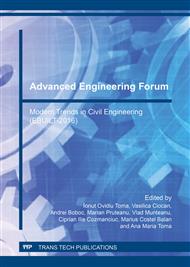[1]
N. M. Newmark, Effect of earthquakes on dams and embankments, Geotechnique. 15 (1965) 139-159.
Google Scholar
[2]
R. Richards, D.G. Elms, Seismic behavior of gravity retaining walls, J. Geotech. Engng Div., ASCE. 105(GT4) (1979) 449-464.
DOI: 10.1061/ajgeb6.0000783
Google Scholar
[3]
R.V. Whitman, S. Liao, Seismic design of gravity retaining walls, Proc. 8th WCEE, San Francisco. Vol. 3 (1985) 533-540.
Google Scholar
[4]
N.N. Ambraseys, J.M. Menu, Earthquake-induced ground displacements, Earthq. Engng Struct. Dyn. 16 (1988) 985-1006.
DOI: 10.1002/eqe.4290160704
Google Scholar
[5]
R. W. Jibson, Predicting earthquake-induced landslide displacements using Newmark's sliding block analysis, Transport. Res. Rec. Paper No. 930182 (1993) 29-38.
Google Scholar
[6]
Z. Cai, R.J. Bathurst, Deterministic sliding block methods for estimating seismic displacements of earth structures, Soil. Dyn. Earthq. Eng. 15 (1996) 255-68.
DOI: 10.1016/0267-7261(95)00048-8
Google Scholar
[7]
J.D. Bray, T. Travasarou, Simplified procedure for estimating earthquake-induced deviatoric slope displacements, J. Geotech. Geoenvironmental Eng. 133 (2007) 381-92.
DOI: 10.1061/(asce)1090-0241(2007)133:4(381)
Google Scholar
[8]
R.W. Jibson, Regression models for estimating coseismic landslide displacement, Eng Geol. 91 (2007) 209–218.
DOI: 10.1016/j.enggeo.2007.01.013
Google Scholar
[9]
A. Arias, A measure of earthquake intensity. In: Hansen, R.J. (Ed. ), Seismic Design for Nuclear Power Plants. Massachusetts Institute of Technology Press, Cambridge, MA. (1970) 438-483.
Google Scholar
[10]
G. Saygili, E.M. Rathje, Empirical predictive models for earthquake-induced sliding displacements of slopes, J. Geotech. Geoenvironmental Eng. 134 (2008) 790-803.
DOI: 10.1061/(asce)1090-0241(2008)134:6(790)
Google Scholar
[11]
E.M. Rathje, G. Saygili, Probabilistic assessment of earthquake-induced sliding displacements of natural slopes, Bull. New Zeal. Soc. Earthq. Eng. 42 (2009) 18-27.
DOI: 10.5459/bnzsee.42.1.18-27
Google Scholar
[12]
S.Y. Hsieh, C.T. Lee, Empirical estimation of the newmark displacement from the arias intensity and critical acceleration, Eng. Geol. 122 (2011) 34-42.
DOI: 10.1016/j.enggeo.2010.12.006
Google Scholar
[13]
A.G. Franklin, F.K. Chang, Permanent displacement of earth embankments by Newmark sliding block analysis, Misc. Paper S-71-17, Soil and Pavements Lab., US Army Eng. Waterways Expt. Stn., Vicksburg, Miss. (1977).
Google Scholar
[14]
F. Leyton, J. Ruiz, J. Campos, E. Kausel, Intraplate and interplate earthquakes in Chilean subduction zone: A theoretical and observational comparison, Phys. Earth Planet. In. 175 (2009) 37-46.
DOI: 10.1016/j.pepi.2008.03.017
Google Scholar
[15]
T.H. Heaton, S.H. Hartzell, Earthquake hazards on the Cascadia subduction zone, Science. 236 (1987) 162-168.
DOI: 10.1126/science.236.4798.162
Google Scholar
[16]
I.M. Idriss, Earthquake ground motions at soft soil sites, Proc. 2nd Int. Conf. on Recent Adv. in Geotech. Earthquake Engrg. and Soil Dyn. Vol. 3 (1991) 2265–2271.
Google Scholar
[17]
G.R. Saragoni, M. Astroza, S. Ruiz, Study of the accelerogram destructiveness of Nazca plate subduction earthquakes, Proc. 14th World Conf. on Earthquake Engrg., China. (2008).
Google Scholar
[18]
E. Garini, G. Gazetas, Destructiveness of earthquake ground motions: Intensity Measures, versus sliding displacement. Proc. 2nd Int. Conf. on Performance-Based Des. in Earthquake Geotech. Engrg., Taormina, Italy. Paper No. 7. 07 (2012), 886-899.
Google Scholar


